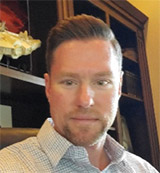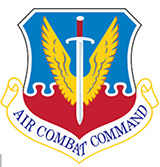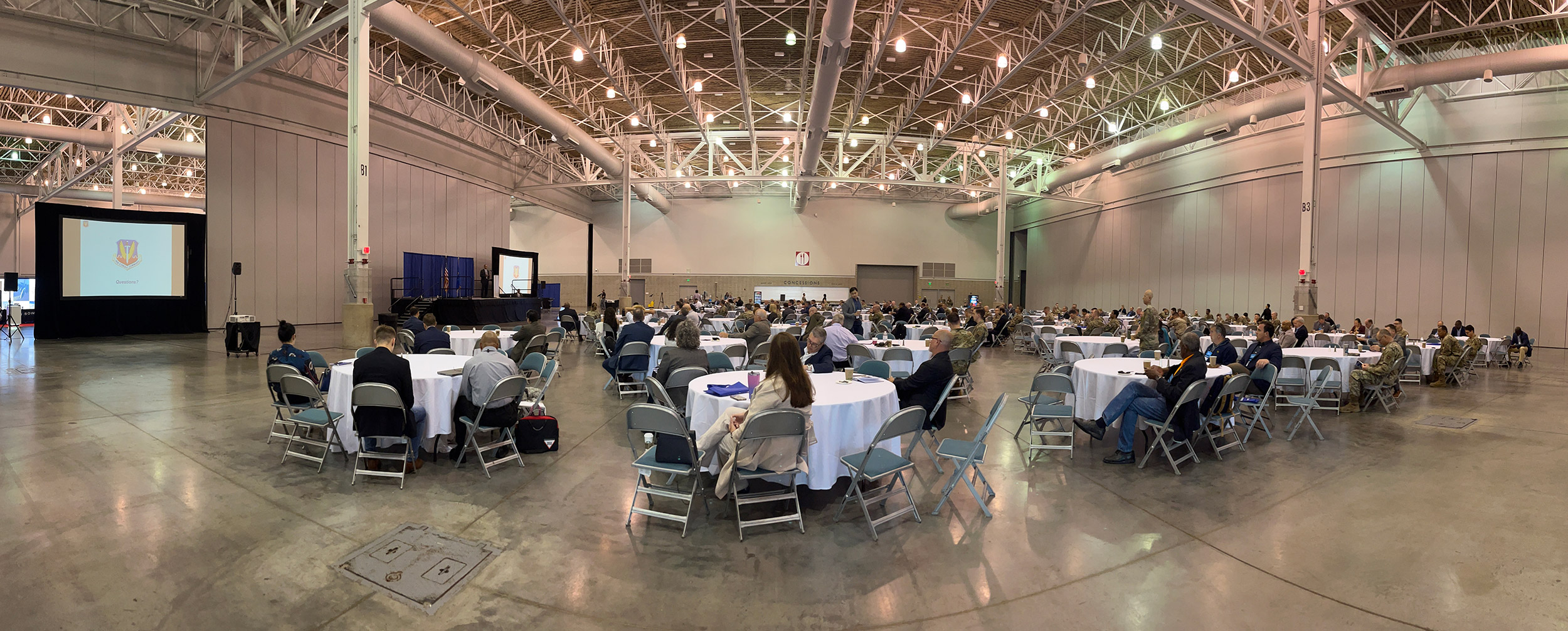
Photo from TWICS 2023
Tentative Program, subject to change based on speaker requirements
MONDAY
0800–1600
ACC Industry Day Event
Details Coming Soon
Details Coming Soon
Details Coming Soon
Details Coming Soon
Details Coming Soon
Details Coming Soon
Details Coming Soon
Details Coming Soon
Details Coming Soon
Details Coming Soon
Each directorate has their own breakout room and one-on-ones are scheduled for 20 minutes (9 slots per directorate).
AFCEA Small Business Seminar
AMIC Contracting Officer Panel/Room 102 – 1 hr
AFCEA Small Business Seminar
0900–1200
Training Session
Location: Conference Room C
Speaker: Mr. Doug Johnson,
Enterprise Architect at Hewlett Packard Enterprise
Summary:
This course provides an in-depth exploration of the HPE Edgeline EL8000 Converged Edge System and the HPE ProLiant e910 Server Blade, designed to empower tactical communicators to leverage data-intensive and low-latency services critical for advanced media delivery, connected mobility solutions, and resilient infrastructure. By enabling real-time data processing directly at the edge with the HPE Edgeline system, warfighters can harness open standards for enhanced flexibility and cost efficiency.
Learning Objectives
- System Overview: Acquire a deep understanding of the HPE Edgeline EL8000 and HPE ProLiant e910 Server Blade’s roles, benefits, and applications in edge computing.
- Installation & Configuration: Learn essential setup steps and hands-on configuration techniques to maximize system performance and reliability.
- Operational Resilience: Master strategies for ensuring uninterrupted edge computing in disconnected or remote environments.
- Enhanced Connectivity: Explore how to integrate CBRS private 5G and advanced Wi-Fi technologies for superior communication and data transfer.
- Security in Sensitive Deployments: Understand the implementation of secure communication for classified deployments, focusing on CSfC requirements.
- AI/ML at the Edge: Dive into deploying and optimizing AI and ML applications for advanced analytics and decision-making with HPE systems.
This course equips participants with the skills to deploy, manage, and optimize the HPE Edgeline EL8000 and ProLiant e910 for innovative edge computing solutions, meeting the dynamic needs of modern CSPs.
Speaker Bio:
Doug Johnson is a seasoned Enterprise Architect at Hewlett Packard Enterprise, recognized as a subject matter expert in high-performance edge solutions. With a robust background in delivering mission-critical systems within the Department of Defense (DoD), Doug’s expertise spans over a decade of hands-on experience. His tenure includes significant roles such as the Enterprise Architect for the US Air Force, Senior Enlisted Leader in the U.S. Navy Reserve, and System Administrator Team Lead at the Naval Information Warfare Center Atlantic. Doug’s extensive certifications, including AWS Certified Solutions Architect and NVIDIA Certified Associate, underscore his proficiency in advanced technology solutions. His leadership and technical skills have been instrumental in driving innovation and operational excellence, making him a pivotal figure in the field of IT and defense.

Location: Conference Room D
Speaker: Mr. John Westerman,
Sr. Federal Systems Engineer, Illumio
Summary:
More important than ever before with the increase in cyberattacks coupled with the continued work from anywhere. Visualizing your network and host-based microsegmentation breaks the network into smaller segments to prevent adversary lateral movement. In fact, the DoD Zero Trust Reference Architecture (ZTRA) v.2.0 released in October 2022 specifically calls out Micro-segmentation to provide robust protection against lateral movement. In this training session, you will learn about the three ways you can stop the spread of cyberattacks through Zero Trust Microsegmentation.
- Real-time Visibility – obtain a real-time application and workload dependency map as the first step to micro-segmentation.
- Reduce the Dynamic Attack Surface – using micro-segmentation / ring-fencing you can enforce a powerful micro-segmentation policy using the host firewalls.
- Enable Faster Implementation – deploy software sensors on existing hardware and software assets – anything with a firewall without re-architecting your network. This can be done because the focus is on application security and not network security.
Speaker Bio:
John has over 25 years of experience specializing in application and network cyber security, public IP/VPN, global remote access products and integration. He has previously been employed at major corporations such as a network systems engineer at MCI (now Verizon) and as a Senior Sales Engineer at Riverbed Technology. He has worked at Illumio for the past eight years and is a Senior Federal Systems Engineer. He is also an avid ham radio operator and an FAA-certified drone and private pilot.

Location: Meeting Room 101
Speaker: Mr. Bobbie Nooner,
Director of Technical Account Management for Tanium’s Public Sector
Summary:
Students will learn to rapidly identify and remediate cyber security risks across your entire organization.
During this four-hour workshop, you will:
- Identify and quantify risk in an environment around vulnerability, configuration compliance, out-of-date applications, sensitive data, and outdated cryptography.
- Quickly remediate risk by closing compliance gaps, patching operating systems, and updating applications.
- Find unknown/unmanaged devices throughout the environment to further reduce risk.
- Attendees must bring their own laptops to access hands-on labs!
Speaker Bio:
Bobby Nooner is a Director of Technical Account Management for Tanium’s Public Sector team. In this role he contributes to each customer’s success by supporting the Tanium platform in the field and leveraging best practices to deliver mission outcomes. He is a retired Air Force veteran with over 21 years of IT/cyber operations experience.
1300–1600
Training Sessions
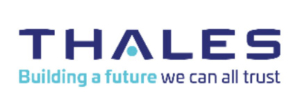
Location: Conference Room C
Speaker: Mr. Jose Morales,
Sr. Sales Engineer & High Speed Encryption SME, Thales TCT
Summary:
High speed networks are the critical foundation that supports many of an agency’s most vital communications and operations. However, this foundation is at risk of surveillance and attack by increasingly sophisticated cyber criminals and well-funded nation states. These network connections, if unprotected, are proving to be highly vulnerable, leaving sensitive assets exposed. So what is the best way to protect network traffic? Encrypt everywhere—between data center to the endpoint whether in the enterprise of at the edge.
Attend this session to learn about the best practices for data in transit including how to:
Protect against common network threats such as eavesdropping, fiber-tapping, harvest and decrypt
Deploy high speed encryption from the core to the cloud to the edge
Improve performance
Mitigate the quantum threat
Address zero trust requirements
Requirements:
Students will need to bring their own laptop (personal) to connect to hand-on lab resources
Speaker Bio:
Jose serves as a Senior Systems Engineer for Thales Trusted Cyber Technologies (TCT). He provides technical, integrated solutions that protect government organizations. Jose has over 25 years of experience working with classified government networks. He currently focuses on providing network encryption solutions that offer enhanced features including bandwidth, performance, reliability, cost efficiency, resiliency, redundancy, and security.
Jose came to Thales TCT after retiring from the U.S Army. His varied background includes Help Desk Supervisor for the Army Cyber Command, COMSEC inspector and auditor for 1ST Special Forces Group Airborne, Special Intelligence Communications Center (SPINTCOM) shift supervisor at the Defense Intelligence Agency (DIA) and instructor at the Army School of Information Technology (SIT)


Location: Conference Room D
Speakers: Mr. Conrad Maiorino,
Cyber Mission Engineer & Russ Smith, Field CTO
Summary:
The Department of the Air Force (DAF) is leading the DoD in deploying and implementing zero trust for the warfighter. Zero trust is rapidly maturing and understanding key concepts is critical for Air and Space Force cyberwarriors. This session will begin with a broad view of the activities necessary to implement zero trust based on guidance from the DoD’s Zero Trust Portfolio Management Office (PfMO). Following that, specific use cases that describe how the DAF can enable secure information sharing within the Air and Space Force enterprise and out to the tactical edge. The session concludes with a demo in a lab environment to expose the audience to practical examples of delivering zero trust concepts to the DoD.
Sections covered:
- Zero Trust Strategic Roadmap
- Use Cases: Enterprise to the Tactical Edge for Joint and Coalition Warfighters
- How Zscaler Implements Zero Trust Concepts
- Hands on demo walk through of Zscaler Internet Access (ZIA) protecting user to Internet facing applications
- Hands on demo walk through of Zscaler Private Access (ZPA) protecting user to private application
Number of seats available: 15 (classrooms can host up to 30 students)
Skill Level: Intermediate (Beginner, Intermediate, Advanced)
Required Materials: A desire to learn
Speaker Bios:
Conrad Maiorino is a Cyber Mission Engineer. A real enthusiast for true customer success with a proven track record for building businesses, high-performance teams and Go To Market strategic alliances. Known as an inspirational leader with strong integrity and 20+ years of driving growth in both public-sector and private theaters, comprising security, cloud, software, and data management at industry-leading Fortune 500 Technology Companies, including Zscaler, Palo Alto Networks, and NetApp.
Russ Smith is a Field CTO supporting Zscaler’s DoD account teams. He joined Zscaler after a 30-year Air Force career culminating as the Deputy Chief Information Officer at the United States Special Operations Command. During his post-military career, he was a research analyst with the Institute for Defense Analyses, the vice president of the cyber practice at SAIC, and a security account lead at Accenture Federal Systems.
Location: Meeting Room 101
Speaker: Christie Karrels, Senior Solutions Architect, Trellix
Summary:
In an ideal world, you wouldn’t have to think twice about your network security. You could operate with complete confidence, knowing your entire infrastructure is safe and sound. But cyber breaches are an unfortunate reality for organizations both big and small. And as threats grow more sophisticated and complex, organizations are forced to deal with their many adverse impacts—from system downtime and financial penalties to reputational loss.
Trellix Network Detection and Response (NDR) uses behavioral techniques like machine learning and advanced analytics to detect network anomalies and analyze raw traffic and flow records to establish baseline network behavior patterns. It allows your team to examine traffic as it crosses the perimeter (north/south) and moves laterally throughout your network (east/west). It also enables you to take advantage of response capabilities to remediate the threat of suspicious network traffic.
Speaker Bio:
Christie Karrels has more than 20 years of cyber security experience at industry-leading technology companies. Christie Karrels is a solutions architect for Trellix, representing the Department of Defense and national security programs. She was previously the Sales Engineer for the large telecommunications and Department of Defense services.
Prior to becoming a solution architect overseeing government initiatives, Christie was responsible for leading engineering efforts involving cyber security, leading DOD security efforts, as well as virtualization security. Since joining McAfee, now Trellix, in 2009, Christie has continued to lead the cyber efforts for DOD customers, focusing on Zero Trust, and protecting our nation’s infrastructure. Christie was previously engineering lead on a number of proposals providing Information Security and Information Assurance expertise. She spent almost 7 years at The MITRE Corporation providing engineering efforts to internal and external customer projects. Prior to working at The MITRE Corporation, Christie was a software instructor and technical writer around systems administration as well as system and network security.
1300–1400
Small Business Forum – Session One
Supercharge your success with an exclusive, power-packed, workshop. Seize this opportunity to meet and learn insights directly from government and industry-leading experts.
Location: RM 102
Speaker: Mr. Jack Longancre
President & CEO, Spartan Shield Solutions

Location: Room 103
Speaker: Mr. Jim Fontana,
Founder of Fontana Law Group, PLLC
Summary:
This session will provide an overview of legal and business issues challenging small businesses in a changing government contracting landscape. It includes the latest developments in small business set aside contracts and other small business statuses (SDVOSB, WOSB, HUBZone), teaming arrangements/subcontracts and joint ventures (including the SBA’s Mentor-Protégé Program), size protests, and the impact of the Supreme Court on SBA’s Section 8(a) program.
Speaker Bio:
Jim Fontana, founder of Fontana Law Group, PLLC, has 40 years of experience as an attorney specializing in government contracts. He has published numerous articles related to government contracting, and has also conducted lectures and courses at multiple universities, law schools and industry forums. Over the years, Jim has received a number of awards and distinctions, including the Association of Corporate Counsel’s Outstanding Chief Legal Officer (2006), Washington Business Journal’s Top Attorney (2005 and 2006), and Washington SmartCEO’s Power Players Award (2014). In 2021 and 2022 he was recognized by Lawyers of Distinction for his expertise in government contracts.
Location: Room 104
Speaker: Alexander Cohen
Summary:
Learn how to unlock the potential of AI to streamline your proposal writing process. This one-hour course is tailored specifically for small business government contractors who have winning proposal language but need more time and resources to pursue more bids, and who want to learn about innovative technologies for crafting compelling, winning proposals with efficiency and precision.
Speaker Bio:
Alexander Cohen is a DC-native who worked in Acquisition Support for an SDVOSB for 5 years, managing a team that awarded $1.2B of procurements for DOI. After that he started writing proposals and helped 8(a)’s, WOSB’s and other SME govcon businesses win over $150M in 3 years. In 2023 he left Google to build GovPro AI, a service that uses procurement experts (pro’s) in combination with AI to deliver high compliance pink team quality proposal drafts to small business government contractors.
1400–1500
Small Business Forum – Session Two
Location: Room 102
Facilitator: Capt. Rose Bennett
 Location: Room 103
Location: Room 103
Speaker:
Mr. Arthur Abrams III, Sr. Director, Corporate Business Liaison, Fusion Cyber Co.
Mr. Chris Etesse
Summary:
Fusion Cyber is a leading-edge cyber security firm providing education and training to college students, active-duty military and their dependents and disadvantage communities. In partnership with CISCO, we offer training on Risk Management Framework (RMF), and certifications for Security+, CISA, CEH, or CISSP. Our firm has graduated and certified over 150 students in less than 1 ½ years directly impacting the nation’s workforce as well as National Security. In addition, our firm has had an impact on the hiring and staffing of qualified cyber security professional in the federal government and commercial spaces and making the nation more competitive against our overseas competitors. Experienced instructors and tutors support the personalized student experience and leverage cutting-edge AI tools to ensure learner success.
One of the greatest values of the 100% virtual program is the ample keyboarding experience offered to students. This experience places them in real-world cybersecurity scenarios that they must solve using their new skills. Through a 100% browser-based cyber range, students do not need a high-end PC or laptop to participate.

Location: Room 104
Speakers:
Bethany Carille, Business Performance Advisor, Insperity
Todd Myer, Insperity
Sophia Evans, HR Specialist, Insperity
Summary:
Human Resources is a key driver of growth and contributes to a business’s bottom line. We will cover an array of topics to help business leaders understand how to build a strong infrastructure for their employees, put processes in place to better manage employer related risks, and attract and retain top talent so their company can thrive.
Speaker Bios:
Bethany Carille is a Business Performance Advisor with Insperity. She works with CEO’s, CFO’s, entrepreneurs, and founders, driving profitability through strategic HR initiatives that have an economic impact. Born and raised in Pittsburgh, PA she now resides in Virginia Beach with her husband and 2 year old daughter. Bethany has a passion for helping others and getting involved in the community, making her role at Insperity a natural fit.
Todd Myer has over 30 years of experience working with companies to tap into the highest potential, requiring a customized approach that reflects the company’s culture, strengths, weaknesses and opportunities. He has developed the ability to understand what there is to know about the organization: the vision, the mission, and the skills and potential of the people within the organization.
Sophia Evans has more than 20 plus years of experience in the Human Resource field from a corporate, government and consultative background. She has worked in a variety of industries including government contracting, higher education and nonprofit. Sophia received her Bachelor of Science in Business Administration from Washington Adventist University and Master of Business Administration from Washington Adventist University. Sophia’s human resource experience has been in different industries with a heavy concentration in the government contracting field. She understands how these organizations work with the Federal Government and a lot of the HR situations that can occur that are specific to their contracts. She is also very familiar with their culture, specifically their employees working at Government sites with Government employees or even reporting to Government managers who may not be part of their organization.
Location: Room 105
Speaker: Mr. Robert Betts, NASA
Summary:
Provide information on doing business with NASA. Discuss NASA opportunities (traditional and non-traditional), provide information on available resources to help find NASA opportunities, and discover ways for small businesses to begin building relationships with NASA and their prime contractors.
Speaker Bio:
Mr. Robert O. Betts is a Small Business Specialist in the NASA Office of Small Business Program supporting the Information Technology Procurement Office (ITPO) and Langley Research Center. As a Small Business Specialist, Mr. Betts plans, implements, monitors, and manages the small business programs for both organizations. He also serves as the advisor for both organizations on all small business matters.
Mr. Betts is an Air Force veteran with nearly 40 years of combined military and civil service. Mr. Betts is a Level III certified Contracting professional and served as a Contracting Officer for 20 years prior to his selection as the Small Business Specialist for NASA Langley in 2018. Mr. Betts was selected to also serve as the Small Business Specialist for NASA ITPO in 2022.
Mr. Betts holds a Bachelor of Arts degree in Business Administration with a specialty in Management Information Systems from Saint Leo University.
1500–1600
Small Business Forum–Break Out Sessions
Location: Room 102
Speaker: Mr. Jack Longancre,
President & CEO, Spartan Shield Solutions
Location: Room 103
Speaker: Mr. Jim Fontana
Founder, Fontana Law Group
Location: Room 104
Speaker:Ms. Bethany Carille, Insperity
Summary:
Employee-supervisor mutual respect, delegating responsibility, accountability
1800–2200
TWICS Communicator’s Banquet
Location: Banquet A

Colonel Hoewing attended the Marine Corps Officer Candidate School (OCS) and was commissioned a Second Lieutenant in August 1997. Upon completion of The Basic School, he reported to Naval Aviation Training Command in Pensacola, Florida and was designated a Naval Aviator in July 2000. In August 2000, Colonel Hoewing reported to Marine Heavy Helicopter Training Squadron 302 at MCAS New River, North Carolina for Replacement Aircrew Training in the CH-53E “Super Stallion.” Upon completion of initial training in April 2001, Colonel Hoewing reported to Marine Heavy Helicopter Squadron 465, Marine Aircraft Group 16 at MCAS Miramar in San Diego, California.
While assigned to the “Warhorse,” Colonel Hoewing completed three deployments to include a UDP cycle to Okinawa, Japan, OPERATION IRAQI FREEDOM I aboard the USS Boxer, and finally the 31st MEU with Marine Medium Helicopter Squadron 265 (REIN) before transferring to Quantico to attend the Expeditionary Warfare School (EWS). Upon graduation of EWS in 2005, Colonel Hoewing was reassigned to Marine Heavy Helicopter Squadron 461. While with “Ironhorse,” Colonel Hoewing attended the Weapons and Tactics Instructor (WTI) course in the fall of 2005. Upon completing WTI, Colonel Hoewing deployed with Marine Medium Helicopter Squadron HMM-264 (REIN) and the 26th MEU.
In July 2007, Colonel Hoewing reported to Marine Aviation Weapons and Tactics School One (MAWTS-1) in Yuma, Arizona to serve as an instructor pilot and as the Assault Support Specialist in the Aviation Development, Tactics and Evaluation (ADT&E) department where he began his work with the Digital Interoperability (DI). Colonel Hoewing was then reassigned to Marine Heavy Helicopter Squadron 362, the “Ugly Angels,” in Kaneohe Bay, Hawaii in December 2010. While with the Ugly Angels, Colonel Hoewing successfully participated in the last combat tour of the CH-53D in support of OPERATION ENDURING FREEDOM 12.2 in the Helmand Province, Afghanistan in 2012.
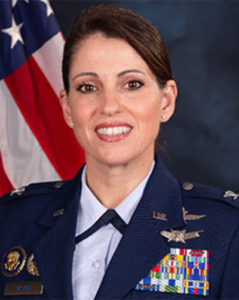 Speaker Bio:
Speaker Bio:
Coming Soon
TUESDAY
0700
Registration — Lobby
0700–0800
Continental Breakfast — Exhibit Hall
0800
Keynote 1
Location: Exhibit Hall
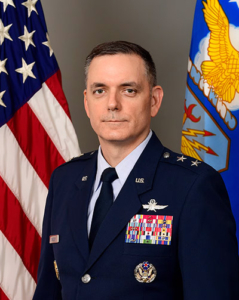
Speaker Bio:
Coming Soon
0900–1600
Networking — Exhibit Hall
0930–1030
Breakout Sessions
Location: Room 102
Speaker: Mr. Jack Longanacre, President & CEO, Spartan Shield Solutions
Panel in work with Jack Longanacre, Ryan Toni, Greg McCarthy, Emily Basile
Summary:
Gov Con growth’s full life cycle from identifying opportunities to bidding and winning contracts to funding your wins. A panel discussion with experts in Pipeline Development, Proposal Development and Management, Pricing and Price to Win Analysis, and Banking for growing Gov Cons.
 Location: Conference Room AB
Location: Conference Room AB
Speaker:Mr. Jason Bonci, Department of the Air Force
Summary:
The Department of the Air Force (DAF) Chief Technology Officer (CTO), Mr. Jay Bonci, will host a breakout session to discuss the API & Data Access enterprise solution for the DAF. The API & Data Access solution places APIs and thoughtful lifecycle management at the core of software design to drive interoperability across technologies and organizations. The discussion will cover recent efforts designing the API & Data Access Reference Architecture and creating the API & Data Access Strategy. You will leave with an understanding of the DAF’s strategic direction and will have an opportunity to bring your own insights and questions to the table to help shape the application framework of the future.
Speaker Bio:
Mr. Jason Bonci is the Department of the Air Force Chief Technology Officer at the Office of the Chief Information Officer. His responsibilities are to drive the adoption, resilience, and strategic technical vision of the Enterprise IT portfolio.

Speaker: Col. Victor Norris, Chief of Information Warfare Division, ACC A326K
Summary:
Col Victor Norris is the Chief of Information Warfare Division, Headquarters Air Combat Command, Joint Base Langley Eustis, Virginia. He is responsible for organizing, training, and equipping Air Force-wide Information Warfare forces and integrating Information Warfare capabilities in support of AF and joint operational missions with 70 military, DoD civilians, and contractors.


Location: Room 103
Speaker: Mr. Sam Ceccola, HPE DoD CTO
Summary:
HPE brings the ability to bring the data center to the tactical edge, by leveraging a SWAP optimized industry standard server that is purpose built for austere environments. The capabilities that can be delivered include Artificial Intelligence and various other edge capabilities to include 5G, Cloud computing, Signal Intelligence and many other mission related workloads.
Speaker Bio:
Sam has over 35 years’ experience in the design and delivery of information technology systems for business and government, with a focus on architectures and solutions including Cloud (Private, Public and Hybrid), Information and Cyber Security, Big Data, Knowledge Management and Mobile Technologies.
In his role as Account Chief Technologist for HPE’s DoD business and Public Sector CTO Lead. Sam is responsible for providing broad technical thought leadership around the pan-HP portfolio, bringing innovative and strategic direction to the account team. Sam also executes as a trusted advisor for the customer, in leveraging his considerable background to help DoD in addressing their IT and mission requirements.
Location: Room 105
Speaker:Dr. Hardiman
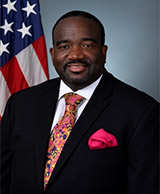
Speaker: Mr. Anthony O. Dillard
Summary:
Provide current status and updates for force renewal, force management, force development, and overall talent management initiatives for the Cyber & IT civilian career field.
Speaker Bio:
Mr. Anthony O. Dillard is the Air Force Civilian Cyberspace Career Field Career Field Manager where he is responsible for civilian cyberspace human capital efforts across the human resource life cycle. He oversees over 11.7K positions to include talent management, force renewal, force development, and force management.
Location: Room 108
Location: Room 109
1030–1130
Breakout Sessions
Location: Conference Room C
Speaker: Colonel Timothy M. Helfrich
Summary:
Data is the lifeblood of the high-end fight. Who can more quickly move the right decision-quality data to the right place at the right time to close kill chains? What’s the lead time between an adversary tactics change to when we field a relevant counter-capability? Success belongs to the side who iterates and learns more quickly; those who do not will find themselves trapped in a negative spiral of paralysis. These kill chains and feedback loops are underpinned by cyber-resilient systems and robust digital infrastructure across the full lifecycle of acquisition and operations. This session focuses on the key culture, policy, process, and technical actions required to effectively execute this “Digital Kill Chain.”
Speaker Bio:
Colonel Timothy M. Helfrich is the Senior Materiel Leader for Advanced Aircraft and Director of the Agile Development Office, which fall under the Program Executive Officer Fighters and Advanced Aircraft Directorate, Air Force Life Cycle Management Center, Air Force Materiel Command. He leads a team of 400 military, civil service, and contract support personnel to develop the Next Generation Air Dominance Family of Systems and other advanced aircraft capability development actives.
Col Helfrich received his commission from the United States Air Force Reserve Officer Training Course, Detachment 220 at Purdue University in May 2002. He has served in a variety of acquisition positions at an Air Logistics Center, the Air Force Research Laboratory, a flight test squadron, Air Staff, the Defense Advanced Research Projects Agency, and a classified program office. He served in key acquisition leadership roles as the Materiel Leader for the Battlefield Airborne Communications Node and the Senior Materiel Leader for Cyber Systems.

Location: Room 102
Speaker: Mr. Micah Yount, Director, Sales Strategy, Iron Bow Technologies
Summary
Tactical communicators must connect to their data from literally anywhere, and that data access can be a matter of life and death. But how do you secure that data from an enemy only miles away, when disconnected from the Enterprise? Iron Bow’s Tactical Edge Zero Trust solution delivers multi-layer Identity and Access Management, ZT Remote Access and ZT Data Security & Exchange at the edge even in a disconnected environment. The time to secure the front lines is now!
Speaker Bio:
Micah Yount is an Air Force retiree with over twenty years of Information Technology experience in the Federal arena. He is currently the Strategic Sales Director for USAF and USSF at Iron Bow technologies. He supports multiple account teams across Iron Bow by developing sales strategies and designing technology architectures and use cases that directly address the mission needs of his DoD customers.
![]()
Location: Room 104
Speaker: Mr. Jim Smid, Palo Alto Networks Federal CTO
Summary:
Learn more about the NSA and NIST lead consortium that is defining the best ways to smoothly transition from a classic crypto environment to a post-quantum secure world.
Speaker Bio:
Jim Smid is the Palo Alto Networks Federal CTO, and he has over 20 years’ experience implementing and managing IT infrastructures in both the commercial and government spaces. His experience is varied with expertise in managed security services, cloud security technologies, storage, virtualization, continuity of operations, data management, operating systems, databases, programming, middleware, and others. During his career, Jim has been Director of Development responsible for the building and deployment of data centers and managed services across eight states, Director of Operations in the telecommunications industry and ran his own company specializing in optimization and data availability.
Location: Room 106
Speaker: Mr. Sean K Hartling, IBM
Summary:
Do you want to utilize AI? AI isn’t as simple as just implementing high performance computers to execute your AI analytics, but you must have a storage solution for data received. Whether on-prem, in the cloud or a hybrid solution. There is NO Artificial Intelligence Without Information Architecture.
Speaker Bio:
Sean K Hartling – 10 years IBM. Sean possesses over 35 years of experience in the Data Storage Management industry. Sean has been engaged in all aspects of data storage solutions, from developer to L2/L3 support to storage architect and is currently a storage Subject Matter Expert with IBM.
Location: Room 108
Location: Room 109
1030–1200
Networking – Exhibit Hall
1200
Lunch — Exhibit Hall
1200–1300
Keynote 2
Location: Exhibit Hall


Summary:
Investments in Communications, Cyberspace Operation, Cyber Security and Information Technology (3CIT) empowers Airmen and Guardians DAF by delivering cutting edge IT and cyber capabilities to the tactical edge. Through the DAF CIO Strategy and our IT investments we deliver capabilities including Generative AI, Zero Trust, Cloud, and EITaaS critical to mission success in Great Power Competition.
Speaker Bio:
Venice Goodwine, a member of the Senior Executive Service, is the Chief Information Officer for the Department of the Air Force. Ms. Goodwine leads three directorates–Enterprise Information Technology, Data and Artificial Intelligence, and Cybersecurity–and supports 20,000 cyber operations and support personnel around the globe with a portfolio valued at $17 billion. Ms. Goodwine also leads career management initiatives for 10,000 IT/Cyber civilian personnel across all human resources facets from recruiting to professional development.
1330–1430
Breakout Sessions

Speaker: Ms. Chandra Donelson, Acting Chief Data and Artificial Intelligence Officer,
Department of the Air Force, the Pentagon, Arlington
Summary:
- Short introduction to Ms. Chandra Donelson, Acting Chief Data and AI Officer
- Discussion to include:
- AI Inventory/launch point
- GenAI roundtables, first one being held a day after the event
- Data and AI governance/strategy
- Partnerships academia and industry
- AI Ethics
Speaker Bio:
Ms. Chandra Donelson currently serves as the Acting Chief Data and Artificial Intelligence Officer, Department of the Air Force, the Pentagon, Arlington, Virginia. In this role, she is responsible for developing and enforcing the Service’s data, analytics, and artificial intelligence (AI) strategy and governance policies, providing oversight for the Service’s data assets, improving data access and use, and fostering an agency wide data culture. Prior to her current role, Ms. Donelson served as the Space Data and Artificial Intelligence Officer, United States Space Force (USSF).
Prior to these roles, she served as the Army Intelligence Community (IC) Deputy Chief Data Officer (CDO) for the Headquarters Department of the Army (HQDA), Deputy Chief of Staff for Intelligence (G-2) from 2021-2023, Pentagon, Arlington, VA. Ms. Donelson also served as the Army OSINT Data Manager for the HQDA G-2 from 2017-2021.
Location: Conference Room D
Summary:
GPC requires digital transformation at the core to be successful… but to transform at speed requires us to think and act differently. This session tackles essential elements of digital transformation from areas such as agile delivery, acquisition flexibility, human capital upskilling, and cyber response… leveraging new ways of acquiring, different approaches to integration (govt AND industry), and new forms of data analysis/team creation. To move GPC at speed, requires digital transformation at speed… and we have more to do!

Location: Rm 103
Speaker: Mr. Marqus Hutchinson, CTO, Intelligent Waves
Summary:
Within the DoD there are many communication infrastructures that do not allow Commanders operating at the edge to achieve decision superiority at the speed, scale and flexibility required. There are several military and commercial links available for this use that can be combined with industry technologies that are made to solve this problem. This session discusses how we merge what is available with the art of the possible, using real world at the edge use-cases, to integrate an Ubiquitous Network Fabric that will deliver resilient connectivity utilizing multiple transports with low probability of intercept (LPI) and a low probability of detection (LPD) concepts.
Speaker Bio:
As the Chief Technology Officer of Intelligent Waves (IW), Marqus Hutchinson has responsibility for establishing IW’s GovCon technical vision & leading all aspects of its technology development, including the IT Department, Training, R&D, and T&E activities. Hutchinson brings experience in Technical Integration, Network Architecting, Data Center Design, Security, Telecommunications Operations, Mobility, & Daily IT Infrastructure Sustainment to various DOD & DOJ Programs. Additionally, he has served as the Program Manager, Chief Architecture Engineer, & Technical
Solutions Architect for DOD & DOJ programs worldwide.
A proactive cybersecurity thought leader & technology innovator in the federal government sector, Hutchinson responds to the nation’s complex security needs as a consultant for the DoD & DOJ. He has more than twenty years of experience in IT infrastructure, including network architecture, data center design, & telecommunications operations.
Hutchinson’s innovative cybersecurity technology leadership has proactively helped elevate
Government IT as Marqus spearheaded the launch of two transformational projects:
1. US AirForce Crowd-Source Flight Data (CSFD): This revolutionary program, a $100 million+ success story, empowers rapid electronic warfare programming, data-driven debriefs, and real-time insights – changing the game for the Air Force.
2. Gorgon Stare Intelligence, Surveillance, & Reconnaissance (ISR): Fielded multiple Forward Processing, Exploitation and Dissemination (OA DCGS/FPED) sites in support of multiple ISR platforms such as Gorgon Stare. Essential to the establishment of a network solution called ISRMAN, that connected multiple OCONUS FPED sites together allowing DCGS sites access to Gorgon Stare data.
Hutchinson holds the following degrees:
- Master of Business Administration, Information Technology Management, Western Governors University
- Bachelor of Science, Information Technology/Network Management, Western Governors University
- Associate of Science, Network Support Services, Florida State College of Jacksonville
Certifications include PMP, CISSP, CCNP, CCDP, CCNA, MCSE, MCSA, CEH, A+ and Network+.
![]()
Location: Rm 105
Speaker: Mr. Patrick Greer,
Senior Solutions Architect, Trellix
Summary:
Learn how your organization meets security requirements such as Zero Trust, CCRI, and OPORD 8600.
Data truly is your most strategic asset. We will delve into how Trellix Data Loss Prevention tools can protect your data – wherever it resides – against accidental and intentional exposure.
- Identification of data leakage risks
- Policies and customized reports
- Classification, analysis, and remediation of data leaks
- Leverage existing infrastructure
- Proactively enforce policies for all types of information
Do you know exactly what sensitive data your organization has, and where it resides? Are you losing sensitive data without even knowing it? Such data loss is not necessarily the work of hackers; your employees also leak data, inadvertently or intentionally. Learn how to protect against external and internal threats and maintain compliance with various regulatory frameworks such as CCRI and OPORD 8600.
Location: Room 107
Speaker: Mr. Greg Porpora, IBM
Summary:
The rapid advancement of Generative Artificial Intelligence (Gen-AI) technology is transforming various sectors and infrastructures globally. Notably, its effect on cybersecurity carries significant implications as policy makers, executives, and cybersecurity experts are incorporating Gen-AI into their operations. At the same time, this innovative Gen-AI technology is also in the hands of the Nation-State threat actors who are aggressively using it to increase the cyber-attacks and threats. As Gen-AI implementation approaches a crucial threshold, a universal Gen-AI attack surface will emerge, compelling organizations to address unprecedented threats. Gen-AI introduces fresh challenges for cybersecurity, necessitating a thorough understanding of its repercussions and the development of effective countermeasures to tackle the evolving threat landscape.
Speaker Bio:
Greg Porpora has over 30 years of experience and is a Distinguished Engineer (DE) Cyber security and advanced analytics; IBM WW Government Cyber Solution team with extensive experience in Cyber security Hybrid Cloud architecture, machine learning, Intelligence systems and cognitive solutions.
He is a retired US Navy Captain Engineering Duty Officer (EDO) Weaponeer holding a high-level security clearance. He is a recognized leader in Cyber security holding multiple AI-based patents, Trade Secret and papers.
Location: Room 108
Location: Room 109
1430–1530
Breakout Sessions

Location: Conference Room C
Speaker:
Mr. Justin Stolpman, ACC 561 NOS/ACC A6/A6T
Mr. Jason Bonci, Department of the Air Force Chief Technology Officer
Summary:
The Department of the Air Force (DAF) Zero Trust (ZT) Functional Management Office (FMO) Director, Justin Stolpman, will sit down with Department of the Air Force Chief Technology Officer (CTO), Jay Bonci, to discuss recent advances for the Zero Trust security architecture. The third release of the DAF Enterprise Zero Trust Roadmap was published on 13 December 2023 to provide a snapshot in time and serve as a strategic guide for cross-enterprise adoption. Through continuous cross-collaboration efforts between the ZT FMO and the CTO team, adjustments are made to track accurate timelines highlighting any major roadblocks that would impede the DoD FY27 target level mandate. You will leave this panel with a heightened understanding of the Zero Trust Roadmap journey and the DAF’s enhanced ability to compete at the Tactical Edge.
Speaker Bios:
Mr. Jason Bonci is the Department of the Air Force Chief Technology Officer at the Office of the Chief Information Officer. His responsibilities are to drive the adoption, resilience, and strategic technical vision of the Enterprise IT portfolio.
Mr. Justin Stolpman is a Department of the Air Force (DAF) civil servant currently dual-hatted as the Director for the DAF Zero Trust Functional Management Office (FMO) located within Air Combat Command (ACC), Directorate of Cyberspace and Information Dominance (A6), and as the Chief of Plans for the Attack Surface Management Center of Excellence within the 16th Air Force, 688th Cyberspace Wing. His responsibilities were charged by the DAF CIO and include reporting, tracking, and orchestrating Zero Trust implementation across all the functional areas.
Location: Room 102

Summary:
We will demonstrate how to use edge and cloud technology to meet The Department of Defense Data, Analytics, and Artificial Intelligence Adoption Strategy by pulling relevant system data from diesel generator sets the DoD already has in their inventory.
Speaker Bio:
Rick Bond has over 24 years of Air Force cyber and maintenance experience. He works with clients who are looking to increase cyber capabilities at the edge and in the cloud. His work with the Air Force is to ensure mission success while at a denied, degraded, intermittent, limited communications environment.
Location: Room 104
Speaker: Mr. Bob Bauman
Founder, President/CEO of Trusted Systems, Inc
Summary:
Mr. Bauman is the Founder, President/CEO of Trusted Systems, Inc., the industry leader in network physical security solutions since its inception in 1988. He invented the IPS Security Container, holds three related patents, and contributed to the Federal specifications and policies controlling physical security for classified network equipment. Previously, Mr. Bauman was an early VAR for Sun Microsystems, and prior to that held sales management positions of computer systems and peripherals for General Electric and Hazeltine. In 1969 Mr. Bauman graduated with a degree in Mechanical Engineering from the University of Wisconsin-Madison.
Speaker Bio:
Dependence on JWICS has been expanding with ever-increasing need for secured remote access, especially for single users. Strict adherence to a fixed SCIF buildout for JWICS restricts its usage, is too expensive, takes too much time to build and is too inflexible. This presentation addresses SCIF shortcomings for single seat JWICS applications, namely securing network devices and user network access. We explore a revolutionary approach to solve these problems in a single seat SCIF alternative that is modular and self-contained tied to the network, not the facility.
Location: Room 106
Speaker: Mr. Chris MacDougald, Lead Engineer

HII’s SABERHUNT small form factor cyber threat hunting kit delivers industry-leading mobility and reliability to U.S. Air Force, U.S. Cyber Command, and other DoD agencies. These kits provide critical network intelligence and have global reach-back support for Cyber Protection Teams (CPTs). SABERHUNT allows defensive cyber operators to incorporate additional resources for evolving mission parameters through our software integration and automation process. As lead system integrator, HII, provides CPTs operating on mission partner networks with state-of-the-art hardware resources in real-time. Whether missions require a smaller footprint or maximum resources, the kit deploys with capabilities exceeding traditional larger static kits. HII’s design provides CPTs with the flexibility to choose the most impactful equipment for the mission. Whether a low profile is needed, operation in extremely austere environments or as rack-mounted traditional-sized hardware kits, our kits will scale to any mission environment.
Speaker Bio:
Chris MacDougald is the Lead Engineer for the SABERHUNT deployable Sensor/Kit. He also serves as the Lead Software Engineer for HII’s Wireless Group in the mobile lab in San Antonio, TX. The Wireless Groups supports USAF customers and specific Combatant Commands with Android based mobile exploit and implant development. He has more than a decade of experience developing mobile applications and remotely executing mobile payloads for DoD and Federal Agency customers. Prior to joining legacy HII companies Alion Science and Technology and MacAulay-Brown, Chris also served in lead software development and design specialist roles with AT&T Government Services, including AT&T’s mobile lab and development team for sensitive projects. He holds a bachelor’s degree in computer science and a master’s degree in Information Systems, both from Tarleton State University.
Location: Room 108
Location: Room 109
1500–1600
Networking — Exhibit Hall
1600–1700
Keynote 3, Speed Networking Panel
Location: Exhibit Hall
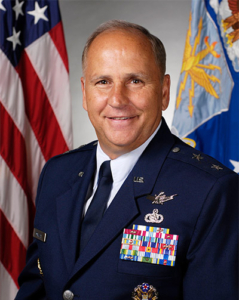
Speaker Bio:
Maj. Gen. John W. Maluda is Director, Cyberspace Transformation and Strategy, Secretary of the Air Force Office of Warfighting Integration and Chief Information Officer, the Pentagon, Washington, D.C. He is responsible for establishing cyberspace as a domain in and through which Air Force flies and fights, to deliver sovereign options for defense of the United States and its global interests. Additionally, he shapes doctrine, strategy, and policy for communications and information activities and serves as the functional advocate for 30,000 personnel.
General Maluda enlisted in the Air Force in 1973 and received his commission in 1978 as a distinguished graduate of the ROTC program at Troy State University, Ala. The general’s career highlights include serving at three major commands, with unified combatant commands, a defense agency, the White House and the Air Staff. Read More
1700
TWICS Sponsored Social — Exhibit Hall
1800
Hall of Fame Induction Dinner
1800 Social; 1900 Dinner Followed by Induction Ceremony
WEDNESDAY
0700
Registration — Lobby
0700–0800
Continental Breakfast — Exhibit Hall
0745
Kickoff
0800–0900
Keynote 4—Ensuring Air & Space Dominance: The Critical Role of Cybersecurity
Location: Exhibit Hall

Summary:
Cybersecurity is not merely a technical concern—it is a strategic imperative that underpins our ability to achieve air, cyber and space superiority. Our adversaries are constantly looking for ways to deny, degrade, and disrupt Air Force missions in the cyber domain. The U.S. must grow and shift to meet the rising challenges. Looking ahead, we recognize that the cyber threat landscape will continue to evolve, presenting new challenges and opportunities. We must remain agile, adaptable, and forward-thinking in our approach to cybersecurity. This means investing in emerging technologies, strengthening our partnerships with industry and academia, and leveraging the power of data analytics and artificial intelligence to stay ahead of the curve.
Speaker Bio:
Dr. Wanda T. Jones-Heath, a member of the Senior Executive Service, is the Principal Cyber Advisor for the Department of the Air Force, comprised of the U.S. Air Force and U.S. Space Force. As the Principal Cyber Advisor for the DAF, her duties include synchronizing, coordinating and overseeing the implementation of the DAF Cyber Strategy and advising the Secretary of the Air Force on all cyber programs. She is responsible for overseeing cyberspace recruitment; resourcing and training of cyber mission forces, as well as assessing their readiness; overseeing acquisition; advocate for cyber investments; cybersecurity supply chain risk management; security of information systems and weapon systems.
0900–1600
Networking — Exhibit Hall
0930–1030
Breakout Sessions
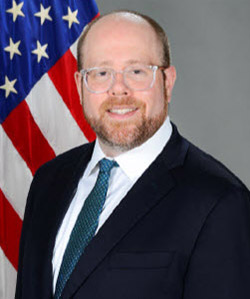 Location: Conference Room AB
Location: Conference Room AB
Speaker: Mr. Jason Bonci, Department of the Air Force
Summary:
The Department of the Air Force (DAF) Chief Technology Officer (CTO), Mr. Jay Bonci, will deliver a keynote on the future of the DAF IT landscape. The keynote will discuss how the DAF, with an empowered CIO, will deliver agility by assembling resilient and interconnected systems that improve the speed, clarity, accuracy, and effectiveness of the kill chain. The audience will leave with an understanding of SAF/CN’s vision to remain competitive with a unified IT environment at home and at the tactical edge.
Speaker Bio:
Mr. Jason Bonci is the Department of the Air Force Chief Technology Officer at the Office of the Chief Information Officer. His responsibilities are to drive the adoption, resilience, and strategic technical vision of the Enterprise IT portfolio.

Speaker: Col. Kevin J. Kirsch, Jr.
Commander, Cyberspace Capabilities Center (CCC)
Summary:
Feeling adrift in the changing landscape of the Air Force? This talk is for you. We’ll explore the “why” behind the Air Force’s modernization efforts, designed to ensure its readiness for future challenges. The path forward involves a strategic shift, embracing technological advancements, personnel system reforms, and a stronger industry partnership – all geared towards achieving dominance at the tactical level.
Speaker Bio:
Col Kevin J. Kirsch, Jr. is the is the Commander, Cyberspace Capabilities Center (CCC), a direct reporting unit to Air Combat Command, at Scott Air Force Base, Illinois. The CCC serves as the Air Force’s front door for cyber & information technology IT requirements. In collaboration with Headquarters Air Combat Command, 16th Air Force and the Air Force Life Cycle Management Center, the CCC provides data-driven, decisionquality information and technical expertise required to design, develop and deploy air, space and cyberspace systems and capabilities into the cyberspace domain. Utilizing an innovative industry standard framework, Information Technology Service Management, the Center integrates new cyber capabilities to today and tomorrow’s warfighters.

Location: Room 103
Speaker: Mr. Brandon Gulla
Chief Technology Officer at Rancher Government Solutions (RGS)
Summary:
Today’s mission landscape demands cloud capabilities but how can the mission thrive when faced with connectivity challenges or even physics getting in the way of operating a LEO satellite? Join Rancher Government as we highlight several challenges the mission ecosystem is facing with the rapid expansion of edge computing and how adopting open source, open-standards can ease your operational burden and accelerate your path to production.
Speaker Bio:
Brandon Gulla is the Chief Technology Officer at Rancher Government Solutions (RGS). In this role he leads the company’s engineering organization and oversees product innovation and development. A self-described distributed systems nerd and open-source contributor, Brandon brings more than 15 years of technical and leadership experience to RGS. Prior to joining RGS, Brandon was a Senior Lead Technologist at Booz Allen Hamilton; a Distributed DevOps Engineer and Software Engineer at Praxis Engineering; a Cyber Software Engineer at Northrop Grumman; and an analyst at Deloitte Consulting. Brandon is a frequent speaker on topics such as Kubernetes, containerization, open-source software, cloud computing and security. Brandon is a two-time WashingtonExec Executive of the Year finalist in both the Chief Technology Officer and Cybersecurity professional categories. He is a graduate of Virginia Tech and completed graduate studies in computer science from Johns Hopkins Engineering for Professionals. Outside of work, Brandon enjoys homebrewing, electrical engineering and spending time with his kids at the Outer Banks of North Carolina.
Location: Room 105
Speaker: Ms. Sky Hackett, CISSP | CISA | GCIA | GCIH, Senior Zero Trust Architect, Amazon Web Services
Summary:
Zero Trust architectures likely include offerings from multiple vendors. How do you collaborate with them to address the Zero Trust activities defined by DoD, CISA, and OMB M-22-09? In this talk, learn how AWS led a consortium of best-of-breed partners to tackle a challenging use case: Zero Trust outcomes at the Edge. We share insights related to integrating ISV products and evaluating the activities defined in the DoD Zero Trust Strategy Guide. We used our experience in this effort to propose DoD CIO Zero Trust Strategy overlays; subsets of target-level activities that apply in different environments.
Speaker Bio:
Sky Hackett brings 15 years of security, compliance, and payments experience to her role as a Senior Zero Trust Architect with Amazon Web Services (AWS). Most recently she has worked with clients looking to implement Zero Trust architectures in AWS, whether on EC2 or in EKS. She works with federal systems integrators, independent software vendors, and government customers to support a partnered approach to implementing Zero Trust in AWS. In her previous role as a Senior Security Consultant for Verizon Enterprise Solutions, Sky co-authored Verizon’s 2017 and 2020 Payment Security Reports and co-edited the 2018 report, as well. Sky earned her bachelor’s degree in Mathematics from the University of Colorado.
Location: Room 107
Speaker: Mr. Bill Edwards, CPP, PSP, PCI, CPD, CIMP
Summary:
The Evolution of Commercial Drones and Security is an awareness and educational update on the precipitous growth of the sUAS ecosystem, specifically the commercial drone platform and its implications on military, government, and private-sector security professionals and the concept of building the “air domain” into comprehensive security program development. Security professionals are at a point now where consideration for the “air domain” should be a major factor in their programs. The presentation will highlight commercial drones through the lens of recent conflict zone actions, creativity, and innovation. This evolution has proven and shown that technology is a security concern and creates risks that have not been addressed properly in conflict and across all societal verticals. The presentation will describe the short history of the commercial drone, highlight the negative implications for conflict and society, address what the future may hold, and recommend simple frameworks to support a security professional’s understanding of the risk. The presentation will highlight the drone expansion in Ukraine and Gaza. Attendees will walk away with an appreciation for the security implications and begin their journey to understanding how to mitigate the risk. Lastly, the presentation will address the current shortfalls in regulation and law surrounding drones and describe the difficulties with the counter uncrewed aerial system (CUAS) technologies and authorities implementing them. We can no longer not afford to “look up!” Let’s keep the conversation going!
Speaker Bio:
COL(R) Bill Edwards retired from the military in 2018 and is now the Executive Vice President of Security Services for PMY Group. Before this role, Bill was CEO and Owner of Phoenix 6 Consulting LLC. Additionally, he led Thornton Tomasetti’s security consulting group as a Principal from 2018 – 2022. Lastly, he joined Building Intelligence as President of the Federal and Public Safety to support Federal awareness of the firm’s trusted access management software. Bill offers over 35 years of expertise in operational/technical security, counterterrorism, counterintelligence, surveillance, and counter-surveillance. He served as the Director of Intelligence for Theater Special Operations Command-North (USSOCOM), a position that required extensive collaboration and partnering across the U.S. whole of government security enterprise. He specifically designed a cohesive and collaborative counter-terrorism network with Department of Defense, Law Enforcement, and Inter-Agency partners while simultaneously bridging strong relationships with coalition partners to further extend his security reach to protect the homeland.
Bill also brings extensive experience in operational/technical security from his combat deployments to Iraq, where he commanded large bases in Al Anbar, Dhi Qar, and Basra Provinces, focusing primarily on operations and security. During this period, he oversaw the planning and execution of all base infrastructure including the implementation and operation of U.S. base security. He also planned and designed multiple levels of security improvements to combat threats. Bill recently published a book titled Inside Abu Ghraib: Memoirs of Two U.S. Military Intelligence Officers. The book is about leading through adversity and the military family during combat operations. He has also published over 100 articles on security-related topics. Bill teaches leadership, strategic communications, and negotiations to senior Air Force officers through the Air Force War College.
Location: Room 108
Location: Room 109
1030–1130
Breakout Sessions
Location: Conference Room C
Speaker: Mr. Justin Stolpman,
ACC 561 NOS/ACC A6/A6T
Summary:
The Department of the Air Force (DAF) Zero Trust (ZT) Functional Management Office (FMO) Director, Justin Stolpman, will sit down with Air Force leaders who are transforming current data security models to a Zero Trust environment. These large operational enhancements require a drastic change to prevent future security breaches. In this panel, you will hear recent progress and necessary shifts from leads in the DAF CDAO, STARCOM CDO and MITRE. Expect to hear how the DAF has navigated challenges faced thus far and how sharing lessons learned can help accelerate ZT implementation in the Data Pillar. You will leave this panel with a heightened understanding of the requirements and considerations for the Department’s Zero Trust Data Pillar approach to competing at the Tactical Edge.

Speaker: Mr. Anthony O. Dillard
Summary:
This session provides an opportunity for individuals to ask questions to a Cyber and IT leadership.
Speaker Bio:
Mr. Anthony O. Dillard is the Air Force Civilian Cyberspace Career Field Career Field Manager where he is responsible for civilian cyberspace human capital efforts across the human resource life cycle. He oversees over 11.7K positions to include talent management, force renewal, force development, and force management.
Location: Room 104
Speakers:
Mr. John Arnold, IBM Consulting Lead Client Partner for the US Air Force and US Space Force
Ms. Cindy Walker, IBM Vice President, Data Management and Analytics Center of Excellence
Summary:
Twenty First Century warfighting and Great Power Competition is rapidly redefining the requirements to support current and next generation airpower. Speed, stealth, maneuverability and weapons now share prioritization with secure connectivity, reliable data delivery and insights at all echelons of command and mission execution, and agile and adaptive forces that are precisely informed, equipped, and trained to deliver airpower effects that hold the enemy at risk, even at vast range.
Speaker Bio:
John Arnold is the IBM Consulting Lead Client Partner for the US Air Force and US Space Force. John is responsible for the consulting services business in strategy, definition and delivery of capabilities that support the customer’s digital modernization efforts. He is responsible for leading the IBM Consulting practice to deliver business transformation and hybrid cloud services supporting both enterprise and mission customers. John brings a broad range of industry and technology solution experience, for both commercial and US Federal customers, into his current responsibilities with IBM Consulting. He held various functional and program leadership roles on both commercial aerospace and defense system platforms. John also has extensive professional experience in delivery of commercial enterprise technology platforms and excels at connecting the dots across business, technology, people and organizations with industrial and government customers.
Cindy Walker is a Partner leading the Data Management and Analytics practice in the CTO Group of IBM Federal Consulting. An honors graduate of the University of North Carolina at Chapel Hill, Cindy is an innovator and thought leader who has devoted her decades-long consulting career to helping clients manage and use data to improve performance, reduce risks, increase efficiencies, and deliver enhanced services to citizens. She has served as a strategic advisor and mentor to CIOs, CDOs, and executives in defense, intelligence, healthcare, financial regulatory, and civilian government organizations to raise their levels of data literacy and help overcome significant mission challenges using innovative data management and governance approaches to enhance data visibility, accessibility, security, and trustworthiness.

Location: Room 106
Speaker: Mr. Bobby Nooner,
Director of Technical Account Management for Tanium’s Public Sector
Summary:
Automation is a common yet elusive goal. In this session, Tanium will host a discussion on ways the ARAD platform has automated common tasks to save time for Airmen across the force, and other opportunities that are on the drawing board.
Speaker Bio:
Bobby Nooner is a Director of Technical Account Management for Tanium’s Public Sector team. In this role he contributes to each customer’s success by supporting the Tanium platform in the field and leveraging best practices to deliver mission outcomes. He is a retired Air Force veteran with over 21 years of IT/cyber operations experience.
Location: Room 108
Location: Room 109
1030–1200
Networking — Exhibit Hall
1200
Lunch — Exhibit Hall
1200–1400
Keynote 5
Location: Exhibit Hall

Speaker Bio:
Colonel Jeffrey A. Phillips is the Director of Cyberspace and Warfighting Communications, and Chief Information Officer, Headquarters Air Combat Command, Joint Base Langley-Eustis, Virginia. He leads a staff and two subordinate units responsible for delivering enterprise-level information technology and expeditionary programs to increase the U.S. Air Force’s ability to provide combat forces to Combatant Commanders. Col Phillips provides the strategic vision, policy, guidance, and advocacy to drive the engineering and integration to build, extend, operate, secure, and defend the Air Force portion of the Department of Defense global network. He is responsible to organize, train and equip cyberspace capability and communications for the command’s 35 wings, 1,000 aircraft, 12 bases and 242 worldwide operating locations with 156,739 total force military personnel.
In previous assignments, Colonel Phillips served as the Director of Staff, Headquarters Air Combat Command, Commander, 67th Cyberspace Wing, the Air Combat Command Information Warfare Division Chief, Executive Officer to COMACC, Commander, 390th Cyberspace Operations
Squadron, JBSA-Lackland, TX; Commander, 35th Communications Squadron, Misawa AB, Japan; Chief, Mission Support Colonel
Assignments, Manpower, Personnel, and Services Directorate, Headquarters United States Air Force, Pentagon, Washington DC.


Summary:
Establishing an enterprise baseline for Airmen and Guardians is imperative to accomplish their mission on a unified network. Achieving objectives towards the DAF’s mission relies and builds upon a strong Enterprise IT foundation. Building an Enterprise IT infrastructure for high-tech advanced capabilities coupled with innovative solutions from industry partners to help innovate the mission, not the infrastructure, is critical to the future fight. We can only prepare for Great Power Competition by streamlining EIT capability delivery and innovating mission solutions.
Speaker Bio:
Winston A. Beauchamp, a member of the Senior Executive Service, is the Deputy Chief Information Officer for the Department of the Air Force. He assists the Chief Information Officer in leading three directorates–Enterprise Information Technology, Data and Artificial Intelligence and Cybersecurity–and supports 20,000 cyber operations and support personnel around the globe with a portfolio valued at $17 billion. Mr. Beauchamp integrates warfighting and mission support capabilities by networking and securing air, space and terrestrial assets.
1300–1530
Dedicated to Exhibit Hall Engagement
1330–1430
Breakout Sessions
Location: Room 108
Location: Room 109
1430–1530
Breakout Sessions
Location: Room 108
Location: Room 109
1600–1700
Keynote 6
Location: Exhibit Hall
Speaker Bio:
Maj. Gen. Hensley earned his commission as a graduate of Texas A&M University in1992. After completing his Intelligence Officer Training, he was assigned as a ChiefIntelligence Systems Element at Aviano Air Base, Italy. Maj. Gen. Hensley served invarious operational intelligence assignments including tours at Mountain Home AirForce Base, Idaho; Nellis Air Force Base, Nevada; and Peterson Air Force Base,Colorado. He is a graduate of the U.S. Air Force Weapons School, Joint MilitaryIntelligence College, the School of Advanced Air and Space Studies. He has servedas a Squadron, Group, and Wing Commander as well as a Joint Task Force andCombatant Command Director of Intelligence. Maj. Gen. Hensley supportedcontingency operations during operations Southern Watch, Enduring Freedom, andInherent Resolve. Prior to his current assignment, the general was the Director ofIntelligence for Headquarters United States European Command, Stuttgart,Germany.
1700











